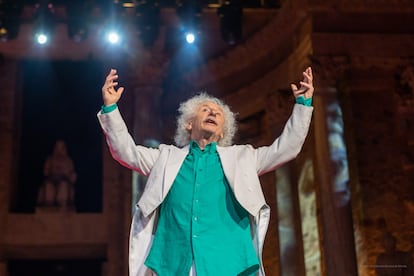They are stories of rabid news created two thousand years ago. With this idea defines the International Festival of Classical Theater of Mérida its director, the Biscay Jesus Cimarro, 59. The work serves as an example Adriano memoriesa recognized narration of emperor advice born in Spain in the year 76 AD written by Marguerite Yourcenar in 1951, the description he makes of the character in his pages could be applied to any time. “I was pleased to make and rebuild the portrait of a man who almost reached wisdom,” he wrote. On this occasion, the work is represented in the first days of August, starring Lluís Homar.
The Mérida Festival is an obligatory reference appointment since its birth, in 1933. Last year those attending the contest almost tripled the figure of the population resident in Mérida. And this 71st edition is on its way to repeating that milestone: in mid -June half of the 100,000 tickets available. “The live show is head and heart. An experience becomes,” says Cimarro on that success. “I think this festival gives you the possibility of feeling.”
The live show is head and heart. An experience becomes. I think this festival gives you the possibility of feeling
Jesús Cimarro, director of the International Festival of Classical Theater of Mérida
The basis of the Festival is the Roman Theater of the city, with more than 2,000 years of history. But the more than 150 representations are also distributed in other scenarios and archaeological spaces of Extremadura. From July 4 to August 31, its uninterrupted schedule catches travelers, lovers or not of culture, in a consolidated summer tourism option that combines representations, dance, circus, musicals, exhibitions or workshops that revolve around the Greco -Roman theme.
“When I assumed the festival’s address, 14 years ago, an average of 50,000 people came. And now they are 180,000,” says Cimarro. Part of its impact is due to the arduous work of marketing and communication, and the decision to program shows that arouse undoubted interest. Above all, those that take place in the Roman Theater. “We propose scenic proposals for a majority audience. We are talking about a capacity of 3,300 locations,” he says.
The contribution of institutions such as Reale Foundation and the project has also been essential Culture with impact of Reale Seguros, who cover their backs before any unforeseen event. “They have been collaborating with us for two decades: they are responsible for the insurance of all the festival shows,” explains the director. In this line of collaboration, Mérida was also the stage of the 20th Anniversary of Reale Foundation in Spain, in 2018. More than 225 people met to recognize the work of the organizations and institutions with which the Foundation has collaborated during this time, and that of the more than 140 people who have participated in the corporate voluntary actions throughout these two decades.
A program that comes out of Spain
Numancia On July 4, the beginning of the International Festival of Classical Theater of Mérida. This production of the theaters of the Madrid Canal Glosa Los Advanzas of the victorious General Escipión who, crowned as a winner in Rome after defeating the Carthaginians, reaches Numancia to conquer it. During the two months many other classics will be represented. Oedipus King, of Sophocles, in charge of the Teatro de Rome Foundation; Consuleswith Rafael Álvarez, The sorcerer; THE ORESTÍA, of Esquilo, in Luis García Montero version; Cleopatra in lovethe musical, starring Natalia Millán and Alex O’Dogherty; either Electrawritten by Eduardo Galán, directed by Lautaro Perotti and starring María León.
In its incessant vocation to grow, the festival leaves the theaters and reaches other disciplines. From exhibitions at the National Museum of Roman art to parades designed for minors. The program will occupy magical archaeological enclaves of the city, such as the temple of Diana, the porch of the forum or the Roman hot springs. “We got Mérida, without being the capital of Spain, to have an impressive projection,” says Cimarro.

The director assures that the festival has become the “flagship of Extremadura culture”, the most projection cultural event in the area. Also for its economic impact, with a collection of 2.6 million euros in 2024, according to the Board of Extremadura. The people from outside stay to sleep, to eat, to buy. “Cultural tourism has a very important basis at this festival,” he confirms. Of the 3,300 beds that the city has, the hotel occupancy in July and August of the last edition was around 80%, according to data from the City of Mérida. The assistant profile is very varied, according to the surveys that Cimarro handles: the Middle Ages is in 44 years and comes from different points, not only from Spain, also from abroad.
The Festival has become the “flagship of Extremadura culture,” according to the director of the festival. The assistant profile is very varied, according to the surveys it manages: the Middle Ages is in 44 years and comes from different points, not only from Spain
The country that brings the most public is Portugal, just 70 kilometers for the A5. That proximity and complicity with the neighboring country has led those responsible for the festival to present some of the works in Lisbon, confirms Cimarro. This year they have further focused on that promotion of internationalization, “which does not mean only matter works, but present the festival in different parts of the world. ”The director lists Buenos Aires, New York, Osaka, Rome …“ We have an agreement with this city to bring shows from Rome and carry some from Mérida. Our intention is to project the festival to the world, ”he confesses. Visitors will be able to understand how classical cultures remain latent in works, roads and emeritenous monuments and how they still portray humans who almost reach wisdom, such as the Adriano de Yourcenar.

